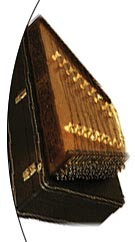Santur
 This is one of what musicologists term a ‘striking cythara.’ That is a Latin word, used to refer to stringed instruments with a large number of strings, each of which produces a particular note on a scale, set out parallel to the resonator. The cythara sound box is generally a box parallel to the chest and back. Such instruments are classified according to the shape of that box and also to the mode of playing them. For instance, the kanun is a ‘plectrum cythara.’
This is one of what musicologists term a ‘striking cythara.’ That is a Latin word, used to refer to stringed instruments with a large number of strings, each of which produces a particular note on a scale, set out parallel to the resonator. The cythara sound box is generally a box parallel to the chest and back. Such instruments are classified according to the shape of that box and also to the mode of playing them. For instance, the kanun is a ‘plectrum cythara.’
It is known that some varieties of harp in Anatolian, Mesopotamian and Egyptian civilisations were sometimes laid down horizontally and played by striking their strings. We may be able to see that as the first known fact about the development of the santur. There is a general view that plectrum cytharae may be earlier than striking ones.
From the point of view of shape the instrument resembles the kanun, and was used for long years in Ottoman music. It has also been used in several Asian and European countries. Yet it was forgetten in Türkiye for a time, perhaps as a result of its being unsuited to the country’s musical system. There was a revival of interest after the early 20th century, although that was still quite restricted.
In contrast to the kanun, both sides of this instrument are trapezoid, the short front widening towards the back. Just like the kanun, the santur consists of groups of three strings stretched over an angled wooden table. The number of these string groups has risen over time. That means that the richness of the sound produced has also increased. The strings are divided into two or three by means of bridges placed on the body of the instrument.
In instruments such as the santur, the strings are turned in groups of three, four or five. The santur is played by striking the strings with little hammers whose ends are covered in rubber.
Sound of the santur (1.07Mb)